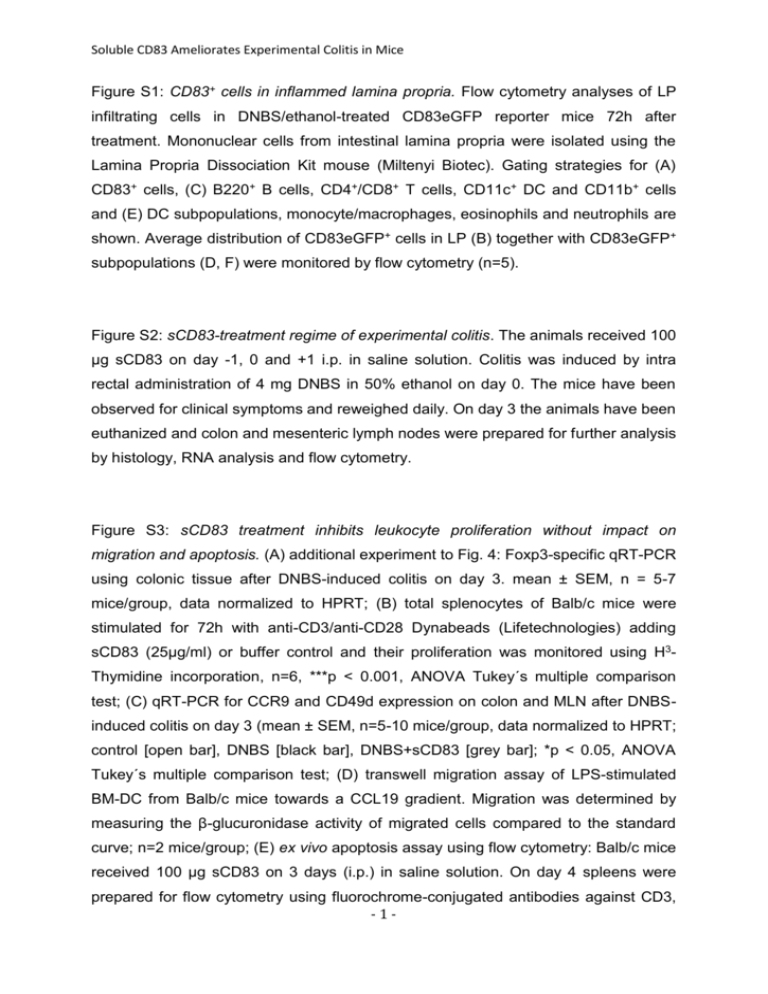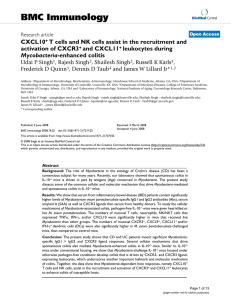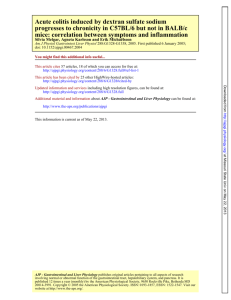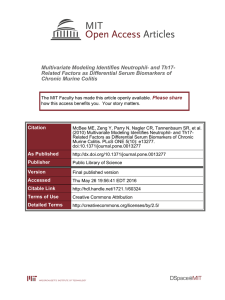Supplementary Figure Legends (doc 38K)
advertisement

Soluble CD83 Ameliorates Experimental Colitis in Mice Figure S1: CD83+ cells in inflammed lamina propria. Flow cytometry analyses of LP infiltrating cells in DNBS/ethanol-treated CD83eGFP reporter mice 72h after treatment. Mononuclear cells from intestinal lamina propria were isolated using the Lamina Propria Dissociation Kit mouse (Miltenyi Biotec). Gating strategies for (A) CD83+ cells, (C) B220+ B cells, CD4+/CD8+ T cells, CD11c+ DC and CD11b+ cells and (E) DC subpopulations, monocyte/macrophages, eosinophils and neutrophils are shown. Average distribution of CD83eGFP+ cells in LP (B) together with CD83eGFP+ subpopulations (D, F) were monitored by flow cytometry (n=5). Figure S2: sCD83-treatment regime of experimental colitis. The animals received 100 µg sCD83 on day -1, 0 and +1 i.p. in saline solution. Colitis was induced by intra rectal administration of 4 mg DNBS in 50% ethanol on day 0. The mice have been observed for clinical symptoms and reweighed daily. On day 3 the animals have been euthanized and colon and mesenteric lymph nodes were prepared for further analysis by histology, RNA analysis and flow cytometry. Figure S3: sCD83 treatment inhibits leukocyte proliferation without impact on migration and apoptosis. (A) additional experiment to Fig. 4: Foxp3-specific qRT-PCR using colonic tissue after DNBS-induced colitis on day 3. mean ± SEM, n = 5-7 mice/group, data normalized to HPRT; (B) total splenocytes of Balb/c mice were stimulated for 72h with anti-CD3/anti-CD28 Dynabeads (Lifetechnologies) adding sCD83 (25µg/ml) or buffer control and their proliferation was monitored using H3Thymidine incorporation, n=6, ***p < 0.001, ANOVA Tukey´s multiple comparison test; (C) qRT-PCR for CCR9 and CD49d expression on colon and MLN after DNBSinduced colitis on day 3 (mean ± SEM, n=5-10 mice/group, data normalized to HPRT; control [open bar], DNBS [black bar], DNBS+sCD83 [grey bar]; *p < 0.05, ANOVA Tukey´s multiple comparison test; (D) transwell migration assay of LPS-stimulated BM-DC from Balb/c mice towards a CCL19 gradient. Migration was determined by measuring the β-glucuronidase activity of migrated cells compared to the standard curve; n=2 mice/group; (E) ex vivo apoptosis assay using flow cytometry: Balb/c mice received 100 µg sCD83 on 3 days (i.p.) in saline solution. On day 4 spleens were prepared for flow cytometry using fluorochrome-conjugated antibodies against CD3, -1- Soluble CD83 Ameliorates Experimental Colitis in Mice CD11b, CD11c, CD19 to distinguish major leukocyte populations, and 7-AAD together with Annexin V to monitor cell survival as follows: 7-AAD-/Annexin V- = healthy, 7-AAD-/Annexin V+ = apoptotic AAD+/Annexin V- = dead; n=5 mice and /group; 7-AAD+/Annexin V+ plus 7(F) Representative colonic photomicrographs of characteristic Ki67 (top) or caspase-3 (middle) and caspase-8 (bottom) are shown at day 4 post first sCD83 i.p. treatment (right) or buffer control (left) (as described above). Ki67, caspase-3 and -8 immunofluorescence is depicted in red and Hoechst 33342 nuclear staining is depicted in blue. n=5 for each condition. Original magnification 20×. Figure S4: IDO inhibitor 1-MT diminished protective effects of sCD83 and increases weight loss in DNBS-treated mice. sCD83- or control- treated DNBS-induced colitis mice were pre-implanted with 1-MT impregnated pellets or vehicle (placebo) and monitored from day 0 to day 3 for (A, B) mortality, and (C) weight loss: total overview of all groups (upper left), only ethanol, DNBS+1-MT+sCD83 and DNBS+Placebo+sCD83 group (upper right), and weight loss at day 3 of DNBS+Placebo vs. DNBS+1-MT and ethanol control; n=10-17 mice/group; mean ± SEM; *p < 0.05, ***p < 0.001, ANOVA Tukey´s multiple comparison test. -2-







